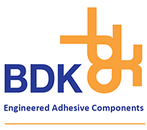Radio Frequency (RF) welding, also known as High Frequency (HF) or Dielectric welding, is a form of bonding that has been around for over 50 years. Although a fairly mature technology, it is a new capability for us here at BDK, and we are excited to introduce it to our clients.
This process uses electromagnetic energy to weld together materials; the electromagnetic waves and pressure heat the material to a point where the molecules are realigned and form a bond. Therefore, the materials are fused together without the use of external heat.
Common Uses for RF Welding
RF Welding is most commonly used for welding thermoplastics, such as:
- Polyvinylchloride (PVC)
- Polyurethanes
- Polyethylene Terephthalate (PET)
- Low-Density Polyethylene (LDPE)
- Ethylene-Vinyl Acetate (EVA)
Other materials that can be used in this manufacturing process are vinyl or coated fabrics. It is not suitable for Polytetrafluoroethylene (PTFE), Polystyrene (PS), Polycarbonate (PC), Polypropylene (PP) or Polyethylene (PE).
There are many reasons why manufacturers, like us, use RF welding in their production:
- You have greater control over the amount of energy that the material is exposed to because once the generator cycles off, the heat is also turned off so the field is no longer energised. Additionally, this control prevents any damage to the material or tools as the heat does not radiate.
- RF welding only requires the materials to bond, no other by-products, so the process is simple as well as clean, saving a lot of production time.
- The tight seal of the bond is air-tight which means that it is not only strong, but also prevents any air, moisture or debris entering.
- One of the main benefits of RF welding is the completeness of the weld and the strength; as it heats the material from the inside out, the bond is so thorough it can withstand pull tests, leak tests and optical tests.
This process does not compromise the durability of the original materials and this is why it is still used today as a popular form of welding. Contact us today to find out more about our new capabilities and what we can do for you.
